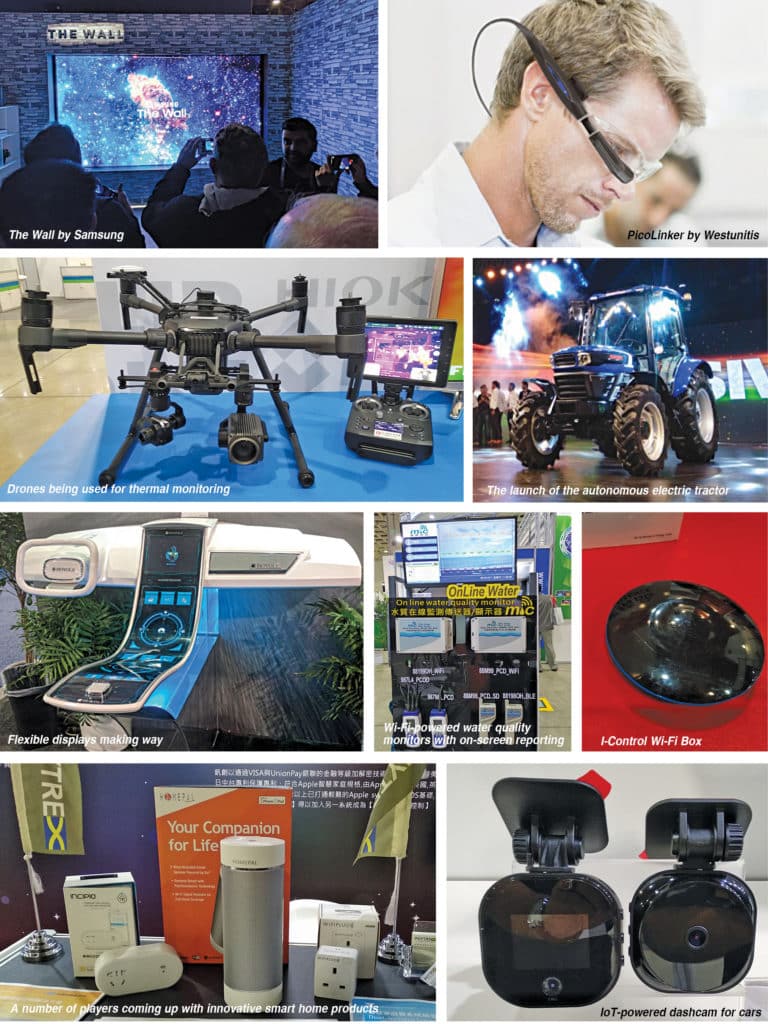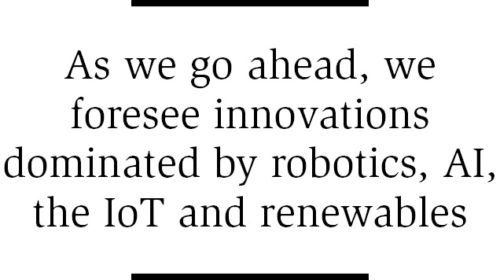In this article we take a look at the various technology trends and interesting solutions we came across while visiting different parts of the globe throughout the year.
Every year brings new opportunities to discover new technological inventions that can deliver real-life improvements. Many of the most-talked-about technologies today were discovered decades ago but have been fitted into practical and innovative applications only recently. India has picked up more pace in innovation by leveraging its strong software skills and improving its hardware capabilities. Other countries around the world have also focussed on bringing forward the best applications of technology at cost-effective prices.
Technologies like machine-to-machine communication, cloud and edge networks, artificial intelligence (AI) and machine learning, unmanned aerial vehicles (UAVs) and low-power wide-area networks (LPWANs), among many others are shaping new-age solutions in healthcare, smart city applications, utility and resource management, surveillance, industries and factories, offices, homes, agriculture, automotive and many other verticals. In this article, we take a look at the various technology trends and interesting solutions we came across while visiting different parts of the globe, in the past year.

Smart wear
The world of smart solutions has been focussed heavily on smart wear lately, with applications ranging from daily use for consumers to applications in industries. Smart watches have gained a lot of popularity. Players like Fitbit, Mi and Indian brands like Goqii are coming up with new fitness bands having upgraded features like real-time cardiac monitoring, blood pressure monitoring, fitness tips and so on.
This year, we came across interesting solutions from newer firms, too. US-based Nanovivo demonstrated WellSign, a fitness band that claims to be able to monitor body fat on a molecular level utilising a non-invasive photonic sensor.
At a B2B level, Tata Communications is upgrading its own wearable band, which can be used by industries to keep tabs on the health, working conditions and security of their factory workers and on-field employees.
Smart glasses are making their way in becoming a popular on-the-go data analysis platform of the future. With concepts being led by Google Glass and Microsoft Hololens, a great number of players around the globe have come up with innovative smart glasses, many keeping in mind unique use cases.
In Japan, we came across interesting solutions like Infolinker, a pair of glasses with a fully-operational computer inside, which processes and analyses data by itself, and PicoLinker connected glasses for displaying data streamed via Bluetooth from a mobile device. These solutions were brought by Westunitis.
We also came across a miniaturised camera that can be attached to glasses, to take pictures when the user blinks in a specific manner.
A pair of smart glasses has been designed by JMACS to be worn by factory workers. It sends visuals of their real-time working conditions and challenges faced to supervisors, essentially helping the latter to become their eyes and enabling quick troubleshooting.
At Consumer Electronics Show (CES) 2018, Las Vegas, we saw smart glasses by Glatus, which can react to fatigue or drowsiness while driving, and can help hearing-impaired drivers react to sound on the road.
Among other innovative wearables, smart shoes by French firm Zhor-Tech use sensors and algorithms to detect snow and warm the feet, to detect fatigue or a disease, and to help stop driving under influence.
Automotive
Electric vehicles (EVs) and connected cars are being considered as the next-generation road riders all over the world. Design elements of automotives are changing with larger involvement of sensors, processing units, powertrains and display screens.
Rear-view mirrors are being integrated or fully replaced by monitors, and can now be operated through controls available near the dashboard. Many of these monitors come with computer vision to help navigate or detect collision risks.
Players like Rohm Semiconductor have been working with auto manufacturers to enable these upgrades.
In Taiwan, we witnessed Askey Computer’s low-power narrowband Internet of Things (NB-IoT) dashboard camera for automotives. It provides clear road view, safety instructions to drivers on-road and real-time navigation updates to car owners.
Gadgets like Rollr Mini by Rollr, a subsidiary company of Samvardhana Motherson Group, connects to the on-board diagnostics (OBD) port of a car to provide various automotive health diagnostics and alerts in real time via a mobile application. It essentially makes a car connected!
Indian startups like HybridRickshaw have come up with an interesting automotive system to convert petrol- or diesel-based two-wheelers into hybrid or full EVs.
Bengaluru-based Okinawa Scooters have designed a battery for its two-wheelers, which can be charged in the manner similar to a smartphone battery.
Escorts Group launched India’s first autonomous tractor earlier last year for farmlands. It features self-driving, precision farming through automated fertiliser and pesticide dispensing, automated safety protocols, vehicle tracking and more.
Safety Cocoon, an AI-powered automotive safe-zone concept by Sony Semiconductors, ensures vehicle safety in various driving circumstances, through 360-degree detection and risk notification.
Inova Semiconductors have introduced their upgraded ISELED automotive lighting technology at 2018 Electronica, Germany. The technology enables dynamic and intelligent backlight control. Up to 4079 digital LEDs on a flexible strip can be controlled by a single external control to generate innovative lighting applications.
Healthcare
Healthcare has been a very important area of focus with the inclusion of miniaturisation, wireless technologies, data analytics and AI. Be it for health monitoring at hospitals or for use at home, we witnessed some interesting innovations throughout the globe, by players from Taiwan, Japan, Germany and the US, among others.
Compal Electronics displayed BoostFix Posture Detector, a non-intrusive medical device that can detect posture problems, internal injuries or joint issues, and enable quick remedy.
We also witnessed how AI platforms can detect levels and conditions of diabetic retinopathy based on image analytics, developed by researchers from Industrial Technology Research Institute, Taiwan (ITRI).
We saw how a cardiac monitoring device can be used similarly to a blood pressure monitor to detect cardiac fibrillation and noises, developed by Ostar Meditech.
CardiNova, an ECG monitor as small as a bandaid, can provide ECG results on-the-fly over Bluetooth to a mobile device, which can be referred to in cardiovascular emergencies.
Another interesting solution, called Spopad, is a kind of rubber pad that clutches on the body surface and electrically stimulates the muscles to cut down excess fat automatically.
Washable smart socks have been designed for diabetic users to detect foot injuries and temperature 24×7. These keep the users alert, since high diabetes often leads to limb loss even through small injuries.
Industrial machines and test equipment
The world is powering ahead into the Industry 4.0 era, which is all about connected work floors, smart factories, automated equipment and organised utilisation of Big Data. Players like Panasonic and Fuji are promoting the idea of dark production floors. This implies a completely automated unmanned production unit, to be supervised by humans over computers only.

Automated machineries are making production processes error-free and increasing production volumes. For example, FAD 2500, a fully-automated dispenser by Musashi Engineering comes with an automatic dispensing volume management system to ensure consistency of dispensing volume.
Robotic technologies are being introduced in industrial machines to optimise their performance. Kenmec Mechanical Engineering demonstrated the inclusion of floor pattern sensors in its industrial vehicles. These can speed up material carriage and logistics while reducing mishaps of vehicles, like disbalance on rough floors, falls from elevated areas or staircases, and so on.
Industrial power management has also improved significantly. We witnessed a power conditioning system by Delta Electronics, which claims to have 97.6 per cent efficiency. It can be used for applications like power quality improvement, load shifting, peak shaving and so on. Users also receive energy analytics for reference.
Indian intelligent robotics firm GreyOrange demonstrated its smart linear sorter and intelligent pick-and-place robot, Butler, which can massively improve warehousing and reduce operations time.
Smart IPBX solutions like Crux LX by Singapore-based Crux Labs and Moreconn, by Taiwan-based Mobiletron, demonstrate how geographically-distributed units and offices can stay connected through audio as well as video, at zero cost.
Popularity of KNX protocol is growing considerably as firms like Mean Well, Schneider and ABB, among many others, are producing KNX-compatible components to make industrial and building automation simple. KNX-compatible products can synchronise with each other to create a complete automation ecosystem that can be utilised in applications like lighting, industrial power failsafe units, medical electronics and more.
Test equipment are adopting the low-power wireless approach, as integration of NB-IoT, Wi-Fi and Bluetooth support are increasing exponentially.
Meter Industrial showcased a group of air-quality and water-quality monitors that are NB-IoT- and Bluetooth-enabled, and send readings wirelessly in real time.
We came across a multichannel LoRa tester by Good Will Instruments, which integrates all major LoRa tests and claims to save testing expenses by up to 70 per cent.
Consumer electronics
Our homes have become a hub of smart devices, essentially making our lives easier and more comfortable. While smart speakers like Amazon Echo or Google Home, and smart lights like Philips Hue, often come up as some of the most popular home automation gadgets, we came across some interesting solutions.

Muse, a smart band to be worn across the forehead, provides EEG results on its accompanying mobile application. It senses the level of calmness of the user and provides real-time tips for relaxation.
For controlling household appliances, we found i-Control Wi-Fi Remote Control Box by AIFA Technology. It converts a smartphone into a remote for any IR-powered appliance (TV, air-conditioner, set-top box, remote-controlled fan, light, etc) through 360-degree IR control.
Micrometre-scale LEDs can redefine TV design and use. Samsung showcased the first modular microLED 371cm (146-inch) TV, called The Wall, at CES 2018. It is a self-emitting TV with micro-LEDs that eliminate the need for colour filters or backlight while producing superior viewing experience.
Bone-conduction technology is an upcoming trend in earphones. In this technology, sound is transmitted across the ear bone instead of occupying the ear canal, enabling users to listen to audio and even speak while keeping the ears free to hear external sounds. Players like BOCO and Human are developing such solutions.
Smart speakers remain popular gadgets, as the year started off with Lenovo announcing its smart speakers in the market.
Computers are also expected to become faster and more powerful, as this year witnessed the launch of Intel i9 processors, which have an overclocking ability of up to 5GHz.
Other applications
There are many more interesting use cases of smart technologies. For instance, we came across a robot that is being used by banks and police for assistive operations.
There are examples of 2.5D printers, brought by players like Casio, that use near-IR lights to generate slightly-elevated print patterns.
Many innovators are working on flexible and foldable digital displays. These are estimated to become a trend in smartphones in the foreseeable future.
Self-driven cars are already being researched, as many technology firms are working on designing secure and precise advanced driver-assistance system (ADAS) platforms.
Drones are becoming increasingly popular as these are being designed for a range of use cases, starting from simple videography to carrying out precise farming in farmlands, as well as for surveillance using thermal imagery.
Way to go
As we go ahead, we foresee innovations dominated by robotics, AI, the IoT and renewables, as these technologies will drive applications in smart cities, buildings, factories, agricultural lands, healthcare and more.
Law authorities are deploying robotic workforces to improve legal compliance. Doctors are referring to AI platforms to ensure 100 per cent accurate diagnoses and treatments.
Corporates are investing in renewable energy sources to reduce environmental impact.
In these ways, we will see more interesting things happening going ahead, and we will look forward to searching them out!






